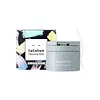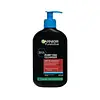Lululun Cleansing Balm Clear Black Versus Garnier Pure Active Anti-Blackhead Charcoal Purifying Cleanser
What's inside
What's inside
 Key Ingredients
Key Ingredients

 Benefits
Benefits

 Concerns
Concerns

 Ingredients Side-by-side
Ingredients Side-by-side

Ethylhexyl Palmitate
EmollientPEG-20 Glyceryl Triisostearate
EmollientIsostearic Acid
CleansingHydrogenated Castor Oil
EmollientSynthetic Wax
AbrasiveEuphorbia Cerifera Cera
AstringentPhytosteryl/Isostearyl/Cetyl/Stearyl/Behenyl Dimer Dilinoleate
Skin ConditioningCharcoal
AbrasiveBentonite
AbsorbentGlycyrrhetinic Acid
Skin ConditioningStearyl Stearate
EmollientSimmondsia Chinensis Seed Oil
EmollientSilk
Malic Acid
BufferingLactic Acid
BufferingLactobacillus/Pear Juice Ferment Filtrate
Skin ConditioningTetrahexyldecyl Ascorbate
AntioxidantArtemisia Vulgaris Extract
Skin ConditioningActinidia Chinensis Fruit Extract
EmollientVaccinium Myrtillus Fruit Extract
Skin ConditioningBetula Alba Leaf Extract
AstringentCitrus Junos Fruit Extract
Skin ConditioningTocopherol
AntioxidantCitric Acid
BufferingEthylhexylglycerin
Skin ConditioningGlyceryl Caprylate
EmollientButylene Glycol
HumectantWater
Skin ConditioningParfum
MaskingEthylhexyl Palmitate, PEG-20 Glyceryl Triisostearate, Isostearic Acid, Hydrogenated Castor Oil, Synthetic Wax, Euphorbia Cerifera Cera, Phytosteryl/Isostearyl/Cetyl/Stearyl/Behenyl Dimer Dilinoleate, Charcoal, Bentonite, Glycyrrhetinic Acid, Stearyl Stearate, Simmondsia Chinensis Seed Oil, Silk, Malic Acid, Lactic Acid, Lactobacillus/Pear Juice Ferment Filtrate, Tetrahexyldecyl Ascorbate, Artemisia Vulgaris Extract, Actinidia Chinensis Fruit Extract, Vaccinium Myrtillus Fruit Extract, Betula Alba Leaf Extract, Citrus Junos Fruit Extract, Tocopherol, Citric Acid, Ethylhexylglycerin, Glyceryl Caprylate, Butylene Glycol, Water, Parfum
Water
Skin ConditioningSodium Laureth Sulfate
CleansingGlycerin
HumectantDecyl Glucoside
CleansingSodium Chloride
MaskingCoco-Betaine
CleansingSalicylic Acid
MaskingVaccinium Myrtillus Fruit Extract
Skin ConditioningSorbitol
HumectantNiacinamide
SmoothingPEG-150 Pentaerythrityl Tetrastearate
EmulsifyingPEG-6 Caprylic/Capric Glycerides
EmulsifyingSodium Hydroxide
BufferingPerlite
AbsorbentPropylene Glycol
HumectantCharcoal Powder
AbrasiveCapryloyl Salicylic Acid
ExfoliatingTetrasodium Glutamate Diacetate
Citric Acid
BufferingMenthol
MaskingPolyglycerin-10
HumectantPolyglyceryl-10 Myristate
Skin ConditioningPolyglyceryl-10 Stearate
Skin ConditioningAcrylates/C10-30 Alkyl Acrylate Crosspolymer
Emulsion StabilisingHexylene Glycol
EmulsifyingSodium Dehydroacetate
PreservativeParfum
MaskingWater, Sodium Laureth Sulfate, Glycerin, Decyl Glucoside, Sodium Chloride, Coco-Betaine, Salicylic Acid, Vaccinium Myrtillus Fruit Extract, Sorbitol, Niacinamide, PEG-150 Pentaerythrityl Tetrastearate, PEG-6 Caprylic/Capric Glycerides, Sodium Hydroxide, Perlite, Propylene Glycol, Charcoal Powder, Capryloyl Salicylic Acid, Tetrasodium Glutamate Diacetate, Citric Acid, Menthol, Polyglycerin-10, Polyglyceryl-10 Myristate, Polyglyceryl-10 Stearate, Acrylates/C10-30 Alkyl Acrylate Crosspolymer, Hexylene Glycol, Sodium Dehydroacetate, Parfum
Alternatives
Ingredients Explained
These ingredients are found in both products.
Ingredients higher up in an ingredient list are typically present in a larger amount.
Citric Acid is an alpha hydroxy acid (AHA) naturally found in citrus fruits like oranges, lemons, and limes.
Like other AHAs, citric acid can exfoliate skin by breaking down the bonds that hold dead skin cells together. This helps reveal smoother and brighter skin underneath.
However, this exfoliating effect only happens at high concentrations (20%) which can be hard to find in cosmetic products.
Due to this, citric acid is usually included in small amounts as a pH adjuster. This helps keep products slightly more acidic and compatible with skin's natural pH.
In skincare formulas, citric acid can:
While it can provide some skin benefits, research shows lactic acid and glycolic acid are generally more effective and less irritating exfoliants.
Most citric acid used in skincare today is made by fermenting sugars (usually from molasses). This synthetic version is identical to the natural citrus form but easier to stabilize and use in formulations.
Read more about some other popular AHA's here:
Learn more about Citric AcidParfum is a catch-all term for an ingredient or more that is used to give a scent to products.
Also called "fragrance", this ingredient can be a blend of hundreds of chemicals or plant oils. This means every product with "fragrance" or "parfum" in the ingredients list is a different mixture.
For instance, Habanolide is a proprietary trade name for a specific aroma chemical. When used as a fragrance ingredient in cosmetics, most aroma chemicals fall under the broad labeling category of “FRAGRANCE” or “PARFUM” according to EU and US regulations.
The term 'parfum' or 'fragrance' is not regulated in many countries. In many cases, it is up to the brand to define this term.
For instance, many brands choose to label themselves as "fragrance-free" because they are not using synthetic fragrances. However, their products may still contain ingredients such as essential oils that are considered a fragrance by INCI standards.
One example is Calendula flower extract. Calendula is an essential oil that still imparts a scent or 'fragrance'.
Depending on the blend, the ingredients in the mixture can cause allergies and sensitivities on the skin. Some ingredients that are known EU allergens include linalool and citronellol.
Parfum can also be used to mask or cover an unpleasant scent.
The bottom line is: not all fragrances/parfum/ingredients are created equally. If you are worried about fragrances, we recommend taking a closer look at an ingredient. And of course, we always recommend speaking with a professional.
Learn more about ParfumVaccinium Myrtillus Fruit Extract comes from the bilberry plant. This plant is native to Eurasia.
Bilberry contains antioxidant compounds called anthocyanins. Anthocyanins help fight free-radicals. Free-radicals are molecules that may damage your skin cells. Fighting off these molecules can help reduce signs of aging.
Vaccinium Myrtillus Fruit Extract also helps reduce irritation.
Learn more about Vaccinium Myrtillus Fruit ExtractWater. It's the most common cosmetic ingredient of all. You'll usually see it at the top of ingredient lists, meaning that it makes up the largest part of the product.
So why is it so popular? Water most often acts as a solvent - this means that it helps dissolve other ingredients into the formulation.
You'll also recognize water as that liquid we all need to stay alive. If you see this, drink a glass of water. Stay hydrated!
Learn more about Water